
Bleaching
Bleaching is a careful cleaning process used in manuscript and document restoration to make yellowed or discolored papers whiter and more readable. It's similar to how we might brighten white clothes, but with specially controlled methods safe for delicate historical documents. Restoration specialists use this technique to remove stains, age-related yellowing, or damage from water and mold, while being very careful not to harm the original text or artwork. This is just one of many conservation methods, along with deacidification and stabilization, that helps preserve important documents for future generations.
Examples in Resumes
Successfully performed Bleaching treatments on 200+ historical documents to remove age-related discoloration
Developed customized Bleaching protocols for sensitive 18th-century manuscripts
Applied controlled Bleaching techniques to restore readability of water-damaged documents
Typical job title: "Paper Conservators"
Also try searching for:
Where to Find Paper Conservators
Professional Organizations
Job Boards
Professional Networks
Example Interview Questions
Senior Level Questions
Q: How do you determine the appropriate bleaching method for different types of historical documents?
Expected Answer: A senior conservator should discuss assessment procedures, testing methods, consideration of paper type and ink composition, and explain how they make decisions about using chemical vs. light bleaching based on document condition.
Q: Describe a challenging bleaching project you managed and how you ensured its success.
Expected Answer: Should demonstrate project management skills, problem-solving abilities, and explain how they developed and implemented treatment protocols while ensuring document safety.
Mid Level Questions
Q: What safety precautions do you take when performing bleaching treatments?
Expected Answer: Should explain protective measures for both documents and conservators, monitoring procedures, and emergency protocols for potential chemical reactions.
Q: How do you document bleaching treatments?
Expected Answer: Should describe their process for before/after documentation, treatment reports, photography, and maintaining detailed records of methods used.
Junior Level Questions
Q: What are the basic types of bleaching methods used in conservation?
Expected Answer: Should be able to explain the difference between chemical and light bleaching, and basic safety procedures for each method.
Q: How do you test for colorfastness before bleaching?
Expected Answer: Should describe basic testing procedures on a small area, observation methods, and when to decide if bleaching is appropriate.
Experience Level Indicators
Junior (0-2 years)
- Basic document handling and examination
- Supervised bleaching treatments
- Documentation and record-keeping
- Understanding of safety procedures
Mid (2-5 years)
- Independent bleaching treatments
- Multiple bleaching methods
- Treatment planning
- Condition assessment
Senior (5+ years)
- Complex treatment development
- Team supervision and training
- Conservation program management
- Research and method development
Red Flags to Watch For
- Lack of knowledge about document testing procedures
- No understanding of chemical safety protocols
- Poor documentation practices
- Inability to explain different bleaching methods
Related Terms
Need more hiring wisdom? Check these out...

Refining Job Descriptions to Expand Applicant Pools: Casting a Wider Talent Net

Who’s Really Running Your Interviews? How to Reduce Bias in Remote Hiring

Breaking the Mold: The Unseen Power of Building a Diverse Leadership Team

